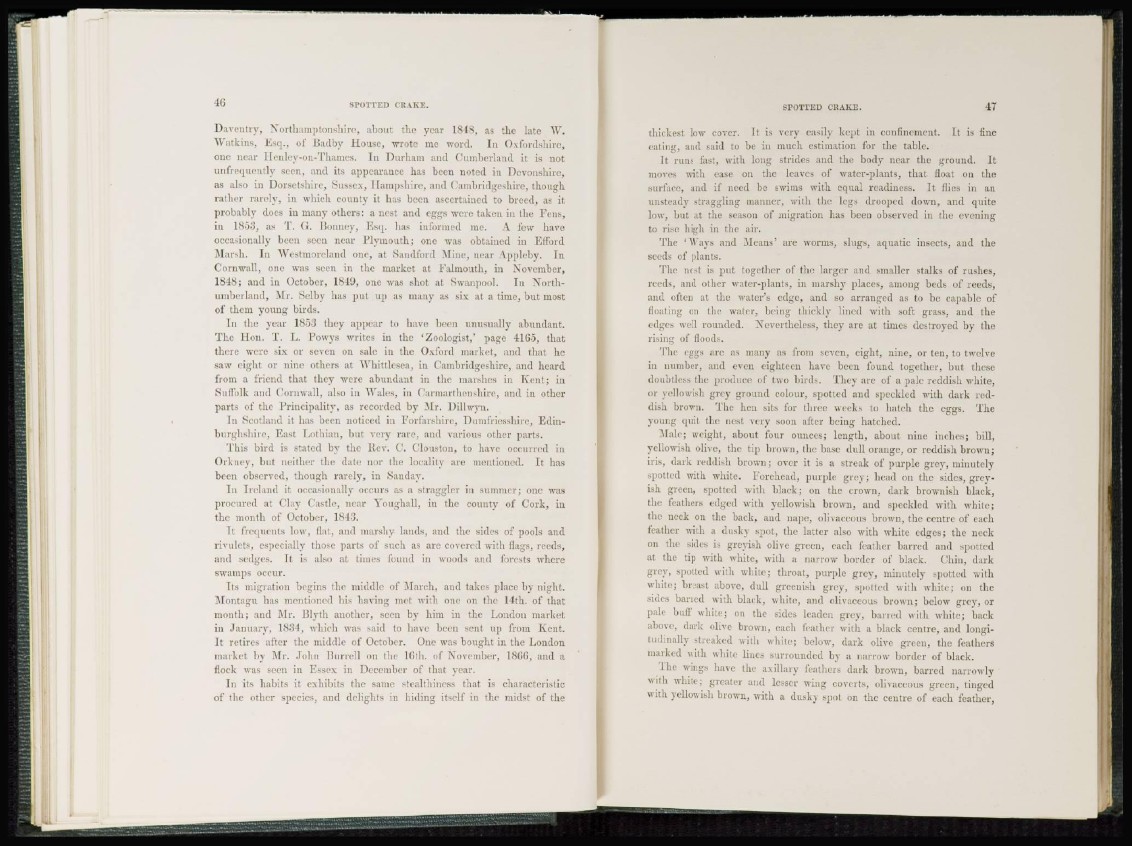
SPOTTED C R A K E.
Da von t r y , Northamptonshire, about the year 1848, as the late W.
Wat kins, Esq., of Bad by House, wrote me word. In Oxfordshire,
one near Henley-on-Thames. In Durham and Cumberland it is not
unfrequently seen, and its appearance has been noted in Devonshire,
as also in Dorsetshire, Sussex, Hampshire, and Cambridgeshire, though
rather rarely, in which county it has been ascertained to breed, as it
probably does in many others: a nest and eggs were taken in the Fens,
iu 1853, as T. (*. Bonney, Esq. has informed me. A few have
occasionally been seen near Plymouth; one was obtained in Eiford
Marsh. In Westmoreland one, at Saudford Mine, near Appleby. In
Cornwall, one was seen in the market at Falmouth, in November,
1848; and in October, 1849, one was shot at Swanpool. In Northumberland,
Mr. Selby has put up as many as six at a time, but most
of them young birds.
I n the year 1853 they appear to have been unusually abundant.
The Hon. T. L. Powys writes in the 'Zoologist,' page 4165, that
there were six or seven on sale iu the Oxford market, and that he
saw eight or nine others at Whittlcsea, in Cambridgeshire, and heard
from a friend that they were abundant in the marshes in Kent; in
Suffolk and Cornwall, also in Wales, in Carmarthenshire, and in other
parts of the Principality, as recorded by Mr. Dillwyn.
I n Scotland it has been noticed in Forfarshire, Dumfriesshire, Edinburghshire,
East Lothian, but very rare, and various other parts.
This bird is stated by the Rev. C. Clouston, to have occurred in
Orkney, but neither the date nor the locality are mentioned. It has
been observed, though rarely, in Sanday.
I n Ireland it occasionally occurs as a straggler in summer; one was
procured at Clay Castle, near Youghall, iu the county of Cork, in
the month of October, 1843.
Tt frequents low, flat, and marshy lands, and the sides of pools and
rivulets, especially those parts of such as are covered with flags, reeds,
and sedges, ft is also at times found in woods and forests where
swamps occur.
Its migration begins the middle of March, and takes place by night.
Montagu has mentioned his having met with one on the 14th. of that
month; and Mr. Blyth another, seen by him in the London market
in January, 1834, which was said to have been sent up from Kent.
It retires after the middle of October. One was bought in the London
market by Mr. John Burrell on the 16th. of November, 18G(5, and a
flock was seen in Essex in December of that year.
I n its habits it exhibits the same stoalthinoss that is characteristic
of the other species, and delights in hiding itself iu the midst of the
S P O T T E D CRAKE. 17
thickest low cover. It is very easily kept in confinement. It is fine
eating, and said to be in much estimation for the table.
It runs fast, with long strides and the body near the ground. It
moves with case on the leaves of water-plants, that float on the
surface, and if need be swims with equal readiness. It flies iu an
unsteady straggling manner, with the legs drooped down, and quite
low, but at the season of migration has been observed in the evening
to rise high in the air.
The ' Ways and Means' are worms, slugs, aquatic insects, and the
seeds of plants.
The nest is put together of the larger and smaller stalks of rushes,
reeds, and other water-plants, in marshy places, among beds of reeds,
and often at the water's edge, and so arranged as to be capable of
floating on the water, being thickly lined with soft grass, and the
edges well rounded. Nevertheless, they are at times destroyed by the
rising of floods.
The eggs arc as many as from seven, eight, nine, or ten, to twelve
in number, and even eighteen have been found together, but these
doubtless the produce of two birds. They are of a pale reddish white,
or yellowish grey ground colour, spotted and speckled with dark reddish
brown. The hen sits for three weeks to hatch the eggs. The
young quit the nest very soon after being hatched.
Male; weight, about four ounces; length, about nine inches; bill,
yellowish olive, the tip brown, the base didl orange, or reddish brown;
iris, dark reddish brown; over it is a streak of purple grey, minutely
spotted with white. Forehead, purple grey; head on the sides, greyish
green, spotted with black; on the crown, dark brownish black,
the feathers edged with yellowish brown, and speckled with white;
the neck on the back, and nape, olivaceous brown, the centre of each
feather with a dusky spot, the latter also with white edges; the neck
on the sides is greyish olive green, each feather barred and spotted
at the tip with white, with a narrow border of black. Chin, dark
grey, spotted with white; throat, purple grey, minutely spotted with
while; breast above, dull greenish grey, spotted with white; on the
sides barred with black, white, and olivaceous brown; below grey, or
pale buff white; on the sides leaden grey, barred with white; back
above, dark olive brown, each feather with a black centre, and longitudinally
streaked with white; below, dark olive green, the feathers'
marked with white lines surrounded by a narrow border of black.
The wings have the axillary feathers dark brown, barred narrowly
with white; greater and lesser wing coverts, olivaceous green, tinged
with yellowish brown, with a dusky spot on the centre of each feather,